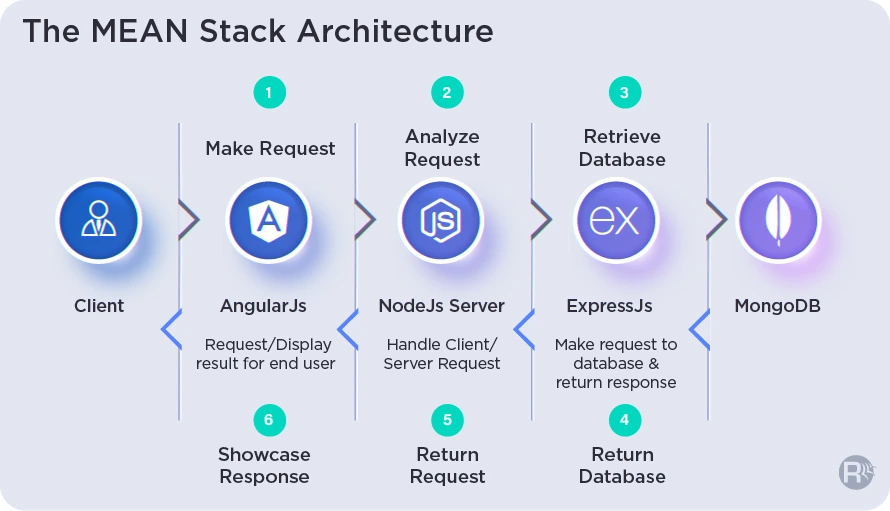What Is MEAN stack in web development?
MongoDB, Express.js, AngularJS, and Node.js make up the MEAN stack. Web development using MEAN stack is a complete JavaScript stack widely used for building cloud-ready apps, which is optimized to build websites and web apps but needs extensive expertise.
These four tools complement one another in creating websites that are reliable, expandable, and up to date.

1. MongoDB
Holding all the information needed to function, the database is considered the heart of the program. Considering this, it’s essential to pay close attention to the features of the chosen database management system, MongoDB.
MongoDB stands out from the crowd as a NoSQL option. It has a unique method of data storage, unlike relational or SQL databases, which solely deal with tables. These newer types may use graphs, key-value associations, broad columns, and documents to support processing and storing data.
Thanks to MongoDB’s data models, you can swiftly add and modify new features as the program evolves and expands. It can also map certain data structures to specific programming languages, which is a major plus for an effective development process.
2. ExpressJS
ExpressJS framework is designed for developing web applications and APIs. It strikes a good mix between user-friendliness and completeness of features.
Operating as a foundation of the MEAN web stack, it also manages all communication between the front end and the database to provide a consistent data flow to the user. Express is straightforward; its error handling and templating features will significantly facilitate your work.
Because it adheres to the CommonJS module standard, Express may shield you against overwriting or over coding to avoid time-consuming mistakes.
3. AngularJS
AngularJS is famous for creating single-page applications, a common type of web app. Being an open-source framework maintained by Google, Angular provides a wealth of helpful tools and frameworks, such as deep linking, data binding, testability stories, reusable components, etc. It also supports HTML syntax and follows an MVC architecture, which helps it operate more stable and less error-prone by breaking down the layers of an application into three parts.
4. NodeJS
Node.js is an open-source JavaScript framework that handles front-end, back-end, and database connections via asynchronous events. As it is easy to scale requests on demand, it is the perfect foundation for websites and web apps.
The MEAN stack relies heavily on NodeJS. Express was designed from the ground up to be used on top of NodeJS, and AngularJS can be easily connected to Node to facilitate rapid data serving. Because NodeJS has a web server, you can quickly and easily move your MongoDB database and application to the cloud.
Scalability is its strongest suit. The framework’s single-thread design enables the application to deliver a fluid user experience across various connections successfully.
MEAN stack architecture
MEAN was created to help programmers deal with open-source JavaScript elements better. Its architecture contains solid frameworks for web development. Yet, how does MEAN programming stack work? How can its components work seamlessly together and become one of the most famous web development stacks?
- First, the MEAN web development stack front-end, AngularJS, will convey the client’s request and transfer it to the back end to process.
- Second, NodeJS will process the request that Angular has received.
- Third, APIs for web apps may be constructed with the help of ExpressJS. It will send the original query to the data store for processing. ExpressJS will connect to MongoDB and call or set the data based on the request type.
- Fourth, MongoDB processes the data; next, it is sent to ExpressJS; last, NodeJS receives the data.
- Fifth, after AngularJS has received the response from NodeJS, it will show the client’s request. You can summarize the entire thing by stating, “AngularJS shows the results that MongoDB generated.”

Why Is MEAN stack good for web development?
1. Fast development
The MEAN Stack architecture is adaptable since you can combine it with various technologies. For instance, the NodeJS and ExpressJS programming languages make it possible to create RESTful APIs that link your application to the MongoDB database.
In addition, NodeJS’s single-threaded nature makes it highly scalable for high-traffic websites or apps where many visitors access your website’s data at once.
2. Scalability & Flexibility
The MEAN Stack architecture is adaptable since it can be used with various technologies. For instance, the NodeJS and ExpressJS programming languages make it possible to create RESTful APIs that link your application to the MongoDB database.
3. Security
Since the MEAN Stack’s back-end and front-end are both written in JavaScript, you can rest confident that your web app will dash securely, and dependably.
4. Easy Collaboration
All MEAN stack web development components are JavaScript based, which facilitates cooperation between developers. Because each portion of the MEAN stack can function without the others, developers may split up their tasks and focus on specific aspects of the project.
5. Good code quality
Using RESTful APIs and Data Transfer Objects (DTOs) guarantees that the quality of the code stays good throughout the development process. In addition, writing unit tests and integration tests (for RESTful APIs) to assure compliance with the specifications makes testing simpler.
6. Open-source and Cost-effective
With its low barrier to entry and ease of use, web development using MEAN stack has quickly become a choice for developing dynamic, mobile-friendly web apps. Considering its free and open-source software usage, the MEAN stack is a cost-effective choice compared to proprietary alternatives.

7. Clouds compatible
The MEAN Stack may be hosted on any cloud platform, including AWS (Amazon Web Services), Microsoft Azure, and Google Cloud.
8. Better development process
With MEAN Stack in Web Development, you can seamlessly transfer codes between frameworks without interrupting each performance. This also means that developers can reuse their codes or components for multiple projects without rewriting them. As a result, it saves time and effort for programmers to focus on more challenging and important tasks.
MEAN stack limitations
1. Loss of data may occur
Though MongoDB is said to be very consistent, this is not always the case. Records that MongoDB has successfully written may be lost if a network split occurs, particularly under extreme traffic conditions.
2. Insufficient popularity
The MEAN Stack framework is still developing and has a way to go before it reaches full maturity. However, because of the small number of developers that have worked with this framework, you may need help locating help from professionals in other countries.
If you’re used to working with relational databases, you will find a different amount of capability with the MEAN stack. Companies like Google and Facebook still choose relational databases because of their superior reliability and stability.
3. Concerns regarding safety
MEAN Stack does not adhere to the OWASP (Open Web Application Security Project) top ten list of vulnerabilities, despite security being a primary priority for all online developers. With this in place, it becomes hard to guarantee foolproof security against hackers and other unwanted app users.
MEAN stack website examples
You can find some prominent MEAN stack website examples that you might have used:
PayPal
Money transfers have never been easier than with PayPal. With AngularJS and NodeJS, it runs more efficiently and processes payments more quickly.
A total of over 325 million people utilize PayPal today. For both component style and payment processing, PayPal relies extensively on AngularJS. Safe financial transactions are implemented with the help of AngularJS, which is used to generate HTML classes and components.
The initial client and server-side code were written in HTML, CSS, and JavaScript. AngularJS and NodeJS engineers are now on staff at PayPal, working in both front and backend roles.
The Weather Channel
This MEAN stack website examples had been utilizing an RDBMS database before, but it had caused problems with some of their more extensive clientele. Because with MongoDB, issues that would have taken weeks to fix were tackled down in a matter of hours.
As a further example, AngularJS is vital to the efficiency and accuracy of The Weather Channel’s basic weather predictions. The site’s worldwide reach necessitates the usage of AngularJS, which is used in the form of many themes that adapt to different locations. You can try the website at weather.com.
Other top brands that leveraged MEAN Stack Web Development: Accenture, Sisense, Fiverr.
When to use MEAN stack in web development
You should consider the Mean Stack Web Development if you want to develop a JavaScript web application or use NodeJS as a back-end. Yet, MEAN has a brother, MERN, which uses ReactJS instead of AngularJS. So, when to choose which?
While the ReactJS front-end can work well with any website and web application, AngularJS excels at single-page applications and simple web applications. This is something you can keep in mind when choosing one or another. MERN works better in terms of enterprise-level applications, so if you only need a simple, dynamic, and lightweight web application, MEAN is the go-to.
At the same time, MEAN is the ideal web development stack for building microservices architecture web/web apps and high-throughput API.
FAQ on MEAN stack web development
As mentioned above, MERN and MEVN are other MongoDB, ExpressJS, and NodeJS web development stacks to consider. Other than that, there are other web development stacks on the market with different features and strengths, such as LAMP or JAM.
There is no specific alternative that works precisely like MEAN. You will need to consider the pros and cons of each web stack to choose the best one.
MEAN stack queries a database from a session or user account; as a result, an attacker might intercept this data for information.
Yet, the MEAN stack offers a clear three-tier separation that, when combined with best practices and proper network isolation, should prevent your end users from accessing the business logic and, more importantly, your database layer. As a result, your application is structured by default to prevent fraudulent user behavior from placing your application in danger (query injection, code manipulation, port spoofing, etc.).
Wrapping up
With its strongest features, the MEAN stack in web development can be ideal for simple web applications, SPA, or a dynamic website. Not only does it save you time and resources, but it also offers a robust and lightweight web solution for every business.
How useful was this post?
Click on a star to rate it!
Average rating / 5. Vote count:
No votes so far! Be the first to rate this post.




